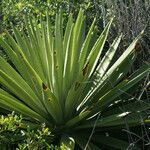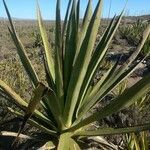Plants medium to large, freely suckering. Rosettes 1.5–2 m high, 2–3 m wide. Leaves linear to lanceolate, 90–130 cm long, 9–12 cm wide, green; margin toothless on mature leaves and with minute teeth on young leaves, or sometimes with antrorsely hooked teeth 2.5–3 mm long, 6–24 mm apart, shiny brown to blackish; terminal spine subulate, 2–2.5 cm long, dark brown. Inflorescence 5–6 m high; scape with triangular bracts; panicles with 10–25 umbellate branches in upper ½ of scape, bulbiliferous after flowering. Flowers 5.5–6.5 cm long, shortly pedicellate, greenish yellow. Perianth tube 15–18 mm long, broadly urceolate; sepals and petals equal, linear to lanceolate, 17–18 mm long, cucullate at apex. Filaments 50–60 mm long; anthers 23–25 mm long. Ovary 20–25 mm long. Fruit not seen.
Stems short, thick. Leaves usually 200--250, in a basal rosette before inflorescence develops, glaucous when young, later dark blue-green, ensiform, straight, usually 1--1.5 m × 10--15 cm, fleshy, adaxially concave, abaxially convex, margin not spiny or rarely spiny, apex straight and tipped with a red-brown spine 2--3 cm. Panicle to 6 m, stout, usually bearing bulblets after anthesis. Flowers with a strong smell; pedicel 5--10 mm. Perianth yellowish green; tube 1.5--2.5 cm; lobes obovate-oblanceolate, 1.2--2 × 0.6--0.8 cm. Stamens inserted at base of perianth lobes; filament yellow, 6--8 cm; anther ca. 2.5 cm. Ovary oblong, ca. 3 cm. Style slender, 6--7 cm; stigma slightly capitate. Capsule oblong, ca. 6 × 2--2.5 cm.
A woody herb. It grows for several years. The leaves come out in spirals and have spines. The leaves occur near ground level. The leaves are sword shaped and 2 m long. The leaves end in a sharp dark brown tip. The plant flowers at maturity. The flowers occur in a stem which can be 6-8 m tall. The flowers are small and green to yellow. The fruit is a dry capsule which contains seed. Few seed will grow. Some flower buds become thick and develop into bulbils. These can be planted and will grow. Suckers are produced at the base of the leaves.









